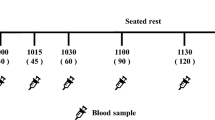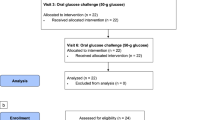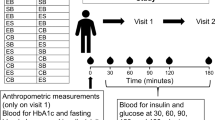Abstract
Glucagon-like peptide-1 (GLP-1) plays an important role in glucose homeostasis. Evidence is emerging that dietary bioactive phytochemicals such as polyphenols can increase GLP-1 concentration in vivo. Spices are rich in polyphenols and have oro-sensory properties, both of which can increase GLP-1 secretion. We therefore investigated the effects of mixed spices intake on postprandial GLP-1 concentration. Using a randomised, controlled, dose-response crossover trial in 20 young, healthy, Chinese men, volunteers were served white rice with 3 doses of curry made with mixed spices and vegetables. These test meals were isocaloric and macronutrient matched. Plasma total GLP-1 concentrations were measured before (baseline) and for up to 3 h after the consumption of test meals. We found a significant dose dependent increase in total AUC of plasma GLP-1 concentrations, adjusted for baseline, with increasing mixed spice doses [adjusted mean (±SEM) of 10568.3 ± 1267.9, 12391.8 ± 1333.94, and 13905.1 ± 1267.6 pg ml−1.min for Dose 0 Control, Dose 1 Curry and Dose 2 Curry respectively (p = 0.019)]. Consumption of polyphenol rich mixed spices and vegetables can therefore increase in vivo GLP-1 concentration.
This is a preview of subscription content, access via your institution
Access options
Subscribe to this journal
Receive 12 print issues and online access
$259.00 per year
only $21.58 per issue
Buy this article
- Purchase on Springer Link
- Instant access to full article PDF
Prices may be subject to local taxes which are calculated during checkout

Similar content being viewed by others
References
Holst JJ, Deacon CF, Vilsbøll T, Krarup T, Madsbad S. Glucagon-like peptide-1, glucose homeostasis and diabetes. Trends Mol Med. 2008;14:161–8.
Drucker DJ. The cardiovascular biology of glucagon-like peptide-1. Cell Metab. 2016;24:15–30.
Holst JJ. The physiology of glucagon-like peptide 1. Physiol Rev. 2007;87:1409–39.
Bodnaruc AM, Prud’homme D, Blanchet R, Giroux I. Nutritional modulation of endogenous glucagon-like peptide-1 secretion: a review. Nutr Metab. 2016;13:92.
Domínguez Avila JA, Rodrigo García J, González Aguilar GA, de la Rosa LA. The antidiabetic mechanisms of polyphenols related to increased glucagon-like peptide-1 (GLP1) and insulin signaling. Molecules. 2017;22:903.
Pérez-Jiménez J, Neveu V, Vos F, Scalbert A. Identification of the 100 richest dietary sources of polyphenols: an application of the Phenol-Explorer database. Eur J Clin Nutr. 2010;64:S112–S20.
Bligh HFJ, Godsland IF, Frost G, Hunter KJ, Murray P, MacAulay K, et al. Plant-rich mixed meals based on palaeolithic diet principles have a dramatic impact on incretin, peptide YY and satiety response, but show little effect on glucose and insulin homeostasis: an acute-effects randomised study. Br J Nutr. 2015;113:574–84.
Hlebowicz J, Hlebowicz A, Lindstedt S, Björgell O, Höglund P, Holst JJ, et al. Effects of 1 and 3 g cinnamon on gastric emptying, satiety, and postprandial blood glucose, insulin, glucose-dependent insulinotropic polypeptide, glucagon-like peptide 1, and ghrelin concentrations in healthy subjects. Am J Clin Nutr. 2009;89:815–21.
Takikawa M, Kurimoto Y, Tsuda T. Curcumin stimulates glucagon-like peptide-1 secretion in GLUTag cells via Ca 2+/calmodulin-dependent kinase II activation. Biochem Biophys Res Commun. 2013;435:165–70.
Kato M, Nishikawa S, Ikehata A, Dochi K, Tani T, Takahashi T, et al. Curcumin improves glucose tolerance via stimulation of glucagon-like peptide-1 secretion. Mol Nutr Food Res. 2017;61:1600471.
Acknowledgements
This project was funded by the Singapore Institute for Clinical Sciences, Agency for Science Technology and Research (A*STAR), Singapore. The authors would like to thank Shalini D/O Ponnalagu for her help with statistical analysis, Susanna Lim for her assistance with phlebotomy and the volunteers for taking part in this study.
Author information
Authors and Affiliations
Corresponding author
Ethics declarations
Conflict of interest
The authors declare that they have no conflict of interest.
Electronic supplementary material
Rights and permissions
About this article
Cite this article
Haldar, S., Chia, S.C. & Henry, C.J. Polyphenol-rich curry made with mixed spices and vegetables increases postprandial plasma GLP-1 concentration in a dose-dependent manner. Eur J Clin Nutr 72, 297–300 (2018). https://doi.org/10.1038/s41430-017-0069-7
Received:
Revised:
Accepted:
Published:
Issue Date:
DOI: https://doi.org/10.1038/s41430-017-0069-7
This article is cited by
-
A single serving of mixed spices alters gut microflora composition: a dose–response randomised trial
Scientific Reports (2021)



